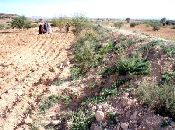| Decision support tool for strategy selection |
 |
|
Authors: Gudrun Schwilch, Felicitas Bachmann and Hanspeter Liniger
Introduction A newly developed comparative selection and decision support tool has been developed for application during Stakeholder Workshop 2. It allows better assessment and negotiation of remediation strategies and support of the negotiation process concerning the best option(s) for a given human and natural environment. The workshop participants conduct a multi-criteria evaluation to rank existing and potential remediation strategies for field trials. This involves stakeholders identifying and weighing relevant criteria (for example, technical requirements, costs and benefits of implementation, social acceptability, etc.), taking into account the technical, bio-physical, socio-cultural, economic and institutional dimensions.
Description of Decision Support Tool
The newly developed Decision Support Tool is the combination of these three elements and not just the DSS software itself.
Overview of steps to reach decision The selection of options is partly done by the research team before the stakeholder workshop starts. They need to prepare the first selection step ahead, as this is too complex to be done during the workshop. It entails going through a series of key questions and using a predefined "search-by-criteria" form to find the most suitable technologies and approaches from the WOCAT databases. The database contains SLM practices from all over the world as well as those local and potential practices identified and documented in part II. The key questions allow for narrowing down the selection regarding climate, land use and other crucial issues. After coming up with a manageable number of solutions (i.e. about 5-10), the specialists have to prepare posters and cards illustrating these solutions, based on a predefined format and an automatic retrieval of the data, but possibly with a necessary translation and adaptations to the local context (i.e. what would this measure cost in their situation).
This Multi Objective Decision Support System (MODSS) software uses decision rules, a hierarchical system for ranking criteria, score functions and linear programming to identify a preferred management option consistent with the ranking of the decision criteria. Assigning an importance order to the decision criteria overcomes in part the need to assign individual weights. The matrix framework of management options and decision criteria is generic and open, encouraging participation by all stakeholders and can accommodate measured data, simulation model results and expert opinions in the decision making process. The results are displayed as horizontal bars with best and worst composite scores; the length of the bars representing the sensitivity of the resource management option to the individual ordering of the criteria. This software is written entirely in platform independent Java and is open source.
The software is used within the stakeholder workshop, but many steps are done on paper and without a computer. Depending on the (computer) literacy level of the participants, more or fewer steps can be done by computer. Ideally, an assistant or the second moderator is feeding the data from each step (results from work done in the different steps) to the Facilitator software. Only the calculations for the analysis of the assessment really need to be made by computer.
The 2-day workshop follows up on what has been discussed in Workshop 1, including recently acquired knowledge from the documentation and evaluation process (Part II). This results in confirming or reformulating the main objectives of an SLM strategy. The moderators will then present the pre-selected possible strategy options to the participants with the help of the posters, and a plenary discussion will allow confirmation of their selection or a search for more options in the database. In a brainstorming session, the stakeholders identify criteria which reflect the most important qualities of the strategy options (e.g. costs, social acceptability, ecological effectiveness, etc.). During a game-like exercise, using the previously prepared cards, the stakeholders are asked to score all options against all criteria. They look at one criterion at a time and score all options against this criterion. The criteria are then organized into three groups, "environmental", "economic" and "social", and ranked within these groups according to their importance. This assigns relative weight to the criteria. Analysis of this scoring and weighting process results in graphs that illustrate the relative merits of the various options. The process is iterative, i.e. criteria, options, scores and rankings may be revised several times until participants are happy with the outcome. Finally, the options have to be negotiated. Options which score high socially, economically and environmentally are most probably the best options. The workshop moderators lead the discussion in such a way that a final agreement can be reached on which solution(s) should be selected for implementation. Commitment is sought from all the stakeholders concerned in how they can support the implementation process.
Reference cited regarding Facilitator software:
|
|||||||||||||||||

Acknowledgement
The DESIRE project was
|
DESIRE brought together the expertise of
26 international research institutes
and non-governmental organisations.
This website does not necessarily
represent the opinion of the
European Commission. The European
Commission is not responsible for
any use that might be made of the
information contained herein. 



